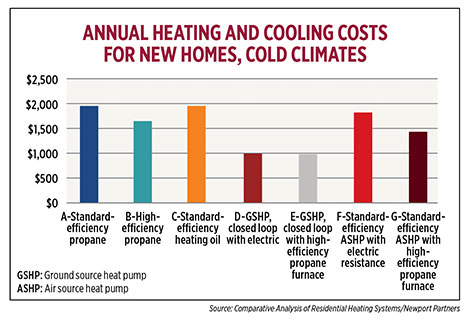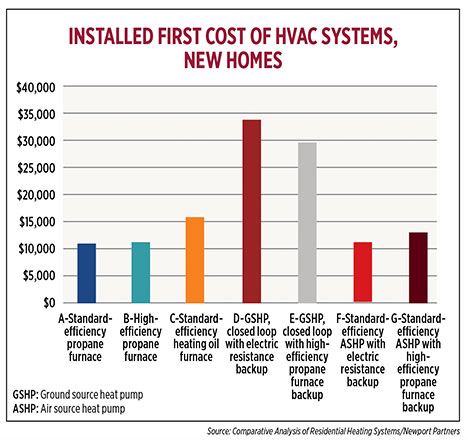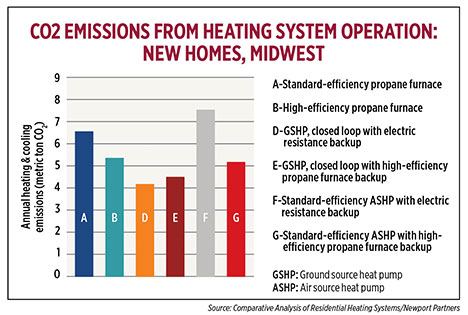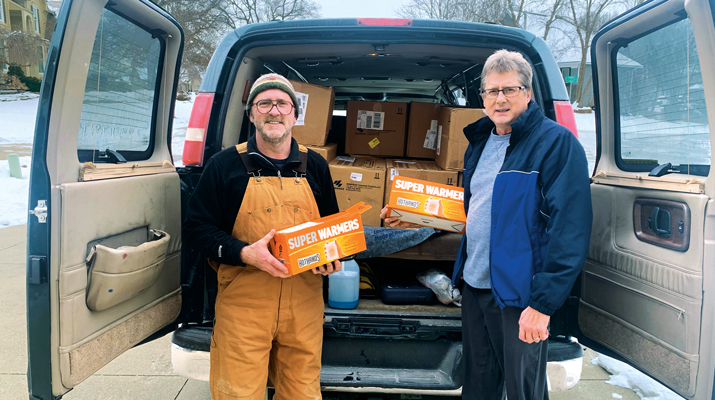Heating up furnace sales for propane retailers
There’s no better method for heating up residential gallons than convincing your customers to install a propane furnace, and the Propane Education & Research Council (PERC) offers an analysis and training course to help you seal the deal.

A heating systems study quantifies propane’s superior furnace performance and helps retailers tailor solutions to customers’ needs. Photo: iStock.com/Smilja Jovanovic
“It’s a great gas load – residential space heating is the bread and butter of the propane industry,” remarks Randy Doyle, who is now semi-retired but still serving in committee leadership positions with both PERC and the National Propane Gas Association.
When pitching propane’s superior warming capabilities and economic benefits, “those numbers have to be clearly understood” by everyone involved in the marketing and purchasing processes, Doyle points out, praising PERC’s heating unit comparison program.
Prepared by consultant Jamie Lyons of Newport Partners LLC under the auspices of PERC’s Propane Training Academy, the Comparative Analysis of Residential Heating Systems study examines the performance of seven heating systems across 16 different locations throughout the United States regarding their “first cost” (equipment and installation, ductwork, air conditioning add-ons, etc.), annual energy cost, emissions amounts, Btu outputs and other qualities.
“You can do a combination of those: What’s the lifecycle cost? There can be emissions considerations for some folks; there can be comfort considerations,” Lyons explains. “So, whether you’re a builder, a remodeler or a homeowner, it’s important to start with ‘What are the objectives that matter most for this project?’ and then assess the possibilities through that lens.”

Click to enlarge. Source: Comparative Analysis of Residential Heating Systems / Newport Partners
When disseminating these details to employees at your company, stress the importance of listening to customers as they discuss their heating needs. A computerized heat-source comparison calculator and hands-on educational options are included with the analysis.
“It’s pretty clear that different decision-makers will have different priorities – understand where your clients stand on those priorities,” Lyons advises.
Your choices may be many as you contemplate a heating system marketing strategy and decide whether to concentrate on the actual residents, HVAC providers or other housing-related professionals such as builders and plumbers.
“There are different objectives that a homeowner or contractor might have,” says Lyons.
Whether you work directly with homeowners or contractors to push propane’s positive heating properties depends on your business model. “We’ve seen marketers use both strategies,” he adds.
Biggest bang for the buck
“All of our markets are a little different,” says Armistead Mauck, owner and vice president of Kinston, North Carolina-based Cherry Energy. “We can only sell what the customer wants. Our challenge is to educate the market; that includes the contractors and the consumers.”
The best way to interest the homeowner with propane as a heating option is to offer “a solution to a current problem or need that we can solve.”
For example, Mauck notes that “in North Carolina the trend is to replace all aging heating systems with heat pumps.” However, this device “fails miserably” in cold conditions.
“We are yet to meet a heat pump owner that does not complain about the comfort of their heat pump when temps drop low and the auxiliary heat comes on,” Mauck muses. “We have a solution.”
The robustness of a furnace certainly remains the focus in regions whipped by serious winter weather conditions.
“North of Cincinnati there are not many heat pumps going on,” observes Marc Foerster, vice president of residential business at Crystal Flash, based in Grand Rapids, Michigan.
With 15 locations, some 30 miles apart, “it’s hard to work with heating contractors in all those markets” due to the volume of people to meet and the challenge of deciding which HVAC business is best suited to forming an alliance, according to Foerster.

Click to enlarge. Source: Comparative Analysis of Residential Heating Systems / Newport Partners
Foerster reports that fewer than 100 Crystal Flash fuel oil furnace users convert to propane annually.
“People will switch when their oil burner breaks down or there’s a change in ownership of the property,” he says.
An older resident, though, is more likely to stick with fuel oil, while a younger homeowner tends to look first at signing up for natural gas service – putting added pressure on propane marketers to make the sale.
“It starts with education, and then you have to get the message out there,” says Nash McMahan, president of Tri Gas & Oil Co., headquartered in Federalsburg, Maryland.
Citing the cold temperatures that can swoop through the Mid-Atlantic region, McMahan declares that propane furnaces are “an easy sell” to homeowners left shivering in December, January and February by an overwhelmed heat pump. They will spend the money on a propane furnace just to enjoy auxiliary warmth.
“People are grateful that they have a backup heat source,” he says.
Investing in a highly trained staff that’s able to communicate confidently with the customers drives the company’s success, according to McMahan.
“PERC gives us the biggest bang for the buck,” he says, praising the extensive “toolkit” of educational materials and training sessions that are available from the organization. “We have to open that toolbox and use those tools.”
Everyone on the Tri Gas staffing roster – from drivers to sales representatives – takes part in the instructional programs.
“We have to make sure that you are well equipped to speak on a variety of topics” when dealing with the public.
Applying appliance rebates
The Missouri Propane Education & Research Council (MOPERC) has provided furnace rebates to Missouri consumers for about two decades. While the amount of the rebates and the marketing have changed over the years, the goal remains clear: Growing demand from home heat.
Residential gallons make up about half of Missouri’s annual propane sales, according to national surveys, driving the council’s renewed focus on encouraging whole-home propane installations.

Click to enlarge. Source: Comparative Analysis of Residential Heating Systems / Newport Partners
The current MOPERC appliance rebate program offers $400 for the installation of a new propane furnace and/or water heater, plus $100 for a propane fireplace, standby generator, cooking stove or clothes dryer, up to $1,000 per site. MOPERC has provided more than $5 million in appliance rebates since the program began.
“We’ve tried several approaches to determine where the best opportunity is,” notes Steve Ahrens, MOPERC’s president. “The council for many years offered rebates for any furnace or water heater installation, in new construction or replacing a competing energy source or existing propane unit. The idea was that we wanted to have it all – attract new burner tips as growth opportunities while at the same time protecting existing gallons from switching fuel sources. That changed this year as appliance rebates are available only for new burner tips.”
A survey of past rebate recipients spurred the decision to end propane-to-propane rebates.
“The marketers do a great job of securing this money on their customers’ behalf, but it didn’t appear to make any difference in the appliance they chose to install,” Ahrens says. “Current propane customers report being happy with our product and so will likely replace an old or defective furnace or water heater with another propane-powered model.”
That insight prompted the council’s decision to increase the rebate amounts (from $300), offer a whole-home program and target new burner tips by engaging homebuilders and those replacing electric, natural gas or wood furnaces.
“The survey showed that our customers are aware of the relative high cost of electricity, the hassle of wood-fired furnaces and the better quality of propane heat over geothermal,” says Ahrens. “The survey affirmed our customers’ satisfaction with the product.”
These survey results will help the council test its messaging approach. For example, certain areas of the Show-Me state saw increases in propane furnaces replacing existing wood heat. MOPERC plans to run radio spots in those markets promoting the hassle-free benefits of propane furnaces and will see if the campaign yields interest.
Similarly, the state’s average electric rate per kilowatt-hour is about twice the cost of propane on a Btu basis, which suggests another strategy.
“Although the past two winters were colder than previous years, they were actually closer in heating degree-days to a normal Missouri winter,” Ahrens says. “We’ve heard from electric customers that geothermal heat doesn’t cut it when the temperatures drop even in a moderate Missouri winter.”
Based on those findings, MOPERC markets propane furnaces as a reliable and cost-effective alternative to electric.
“I’m not sure anyone would immediately replace an expensive ground-source system with any other fuel,” says Ahrens. “But for those doing their research, we want to make the point that propane furnaces are comfortable, affordable and dependable. Geothermal is too expensive to compromise on heat when you need it the most. Propane is a terrific option.”
The council is incorporating its statewide “Welcome Home” message into the rebate efforts by highlighting the benefits of specific applications. MOPERC has set aside $400,000 for its current appliance rebate program that began July 1 and runs through June 30, 2020. Marketers obtain a reservation number to ensure funding. The program can end before the end of the fiscal year if all funds are expended.
“How long we offer the program depends on the winter,” Ahrens says. “Obviously, if we have more gallons sold, the council can choose to supplement the rebate program with those dollars. But even if we don’t see additional gallons, the entire budget is 100 percent funded from the first day of the program. We are committed to that level of support.”
MOPERC will continue to revise and adapt the appliance rebate program as consumers and competition dictate.
“It’s possible that a future council might take another look at propane-to-propane rebates for furnaces or water heaters,” Ahrens says. “We know that natural gas lines in many communities run right past current propane users. A utility could target these homes for conversion, particularly when a long-time customer leaves the home and it hits the market.”
The council is also aware of the increased attention on renewable energy.
“In the meantime, we’re proud of the industry’s legacy of providing customers with clean, affordable, dependable and versatile fuel,” Ahrens says. “In the daily, real-world competition for a customer’s fuel business, propane’s documented advantages can counter the bigger buzz coming from new technologies. They have promises – we just work.”
















